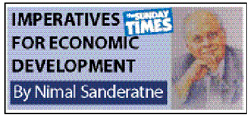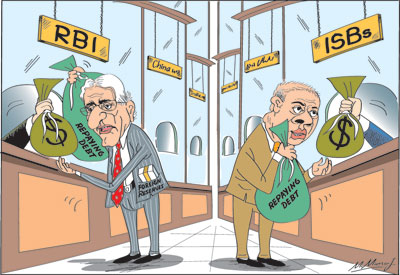Columns
Coping with foreign debt repayment and external financial vulnerability
View(s):The country’s external financial vulnerability is serious due to the accumulated massive foreign debt, large debt repayment obligations and low foreign reserves.
 Furthermore, the difficulty of servicing the large foreign debt obligations of US$ 5.9 billion this year was made more onerous by the political anarchy of last October. The Government is, however, confident of meeting the debt servicing obligations this year.
Furthermore, the difficulty of servicing the large foreign debt obligations of US$ 5.9 billion this year was made more onerous by the political anarchy of last October. The Government is, however, confident of meeting the debt servicing obligations this year.
SLEA annual sessions
Speaking at the 33rd annual sessions of the Sri Lanka Economic Association, Central Bank Governor Indrajit Coomaraswamy assured economists that the Government was taking measures to ensure the debt repayment obligations and maintain adequate foreign reserves. This, he said, was despite the serious financial crisis the country faced due to the October 26 political crisis.
 Financial loss
Financial loss
Dr. Coomaraswamy said the financial loss was the severest among the many losses suffered by the country after the sudden political crisis. Among the losses was the loan assistance agreed to be given by the International Monetary Fund.
The Government was also unable to obtain parliamentary approval to raise Rs. 300 billion for administration expenses. This has caused the Finance Ministry and the Central Bank to face a great difficulty, he added. Further, he said that the nearly two-month long political crisis had a major impact on the economy and the operation of the financial system of the country.
Foreign debt
The Governor noted Sri Lanka will have to pay US$ 5.9 billion in foreign debt repayments in 2019 and the first instalment was US$ 1.6 billion. It had repaid US$ 1 billion by drawing on the country’s foreign reserves, allowing it to drip to a critically low level.
Dr. Coomaraswamy said Sri Lanka was able to escape the debt crisis due to the country’s good international and regional relations, especially that of India and China.
Debt repayment aggravated
The country’s serious external financial vulnerability owing to the accumulated massive foreign debt and debt repayment obligations was made considerably more difficult by the political chaos since October 26. The political anarchy aggravated the country’s external financial vulnerability by an outflow of capital, withholding of foreign assistance, a blow to the booming tourist industry and the downgrading of the country’s international risk ratings, which in turn, increased the costs of foreign borrowing.
Repayment
Dr. Coomaraswamy, who outlined the way in which the large repayment would be made, was confident that the IMF would release the final tranche of the Extended Credit Facility that was halted when the political crisis occurred. He assured the audience that the IMF was now flexible and supportive of the Government’s stabilization measures.
He said the IMF is likely to release the last tranche after consultations in mid-February in Colombo, when the fiscal data for 2018 would be available.
He emphasised that the IMF facility, though small, would boost international confidence and facilitate commercial borrowing.
India and China
The Governor stressed the importance of the assistance of India and China in supporting the reserves. “Sri Lanka’s friends, the two regional giants, have stepped in to support us when we were pushed into a rather difficult corner.” Their combined assistance should replenish the reserves in the next few months.
RBI
The Reserve Bank of India (RBI) agreed earlier this month to provide a $400 million currency swap facility to the Central Bank of Sri Lanka. Dr. Coomaraswamy said: “The RBI’s very rapid and timely assistance will serve to boost investor confidence by supporting Sri Lanka to maintain an adequate level of external reserves.” The Governor said the RBI was likely to provide a line of credit of US$ 1 billion early.
China
The Bank of China has, meanwhile, offered a $300 million loan. Dr. Coomaraswamy said both the RBI and the Bank of China were considering plans to scale up their offers to $1 billion each.
The Bank of China loan is likely to come at an interest rate of about 5.5 percent.
“We are very keen to get this money into our reserves by the end of the month, so that the reserve number published at the end of the money gives sufficient confidence to markets. The $300 million loan being negotiated with Bank of China can be scaled up to $1 billion. The reason we broke it up is because the approval process from the Bank of China side takes a long time, but they could give us $300 million,” Dr. Coomaraswamy said.
In addition, the Central Bank is also working to upscale a $1 billion loan from China Development Bank, which was received in the last quarter of 2018, by a further $500 million. These funds would also be available in February.
International Sovereign Bonds
The Central Bank will also issue an International Sovereign Bond (ISB). Cabinet approval was granted recently to borrow up to $2 billion, of which a large potion would be a dollar denominated ISB. The Central Bank is also expected to issue Panda and Samurai bonds.
“We want to try and get all these transactions done in the first quarter of this year. The job of Central Banks is to prepare for the worst and we learnt a lesson on 26 October. We don’t know what political tsunami might come next, so we have to plan and get the money in as fast as possible.”
State banks
The Bank of Ceylon, the People’s Bank, and the National Savings Bank are raising lines of credit on behalf of the Government. The NSB is negotiating a $750 million line of credit, while the People’s Bank is on a road show in the Middle East. The Central Bank expects the Bank of Ceylon and the People’s Bank to jointly raise US$ 200 to 300 million.
All these loans would certainly replenish the reserves and boost international confidence. However, these being borrowed funds, the country’s foreign debt liability will be increased.
Conclusion
The repayment of debt obligations has been by further foreign borrowing, as foreign reserves were inadequate. This reveals the external financial vulnerability of the economy.
The reasons for this vulnerability are manifold. The large foreign borrowing in the last decade was on commercial terms for high cost infrastructure projects with long gestation periods, and in some instances, no return at all. Consequently, further borrowing to repay debt has increased foreign debt and interest costs.
While most of the foreign debt in the past was at concessional interest rates and long periods of repayment, recent debt stock has been at high commercial lending rates. Over one half of the debt is at commercial rates of borrowing.
The country’s balance of payments has been weak owing to large trade deficits as imports have been about twice export earnings. Fortunately earnings from services and foreign remittance have either offset the trade deficit or reduced it. However the balance of payments surplus, if any, has been too small to replenish the reserves dented by debt repayment. This is the core of the problem.
Way forward
To extricate ourselves from this foreign debt trap, we must be prudent in foreign borrowing, focusing on utilising foreign loans on investments that generate export earnings. We must reduce the trade deficit by increasing exports and reducing non-essential imports. We must adopt monetary and fiscal policies that do not strain the trade deficit and find ways and means of reducing wasteful government expenditure that has high import content.
Failure to adopt such measures will aggravate the economy’s external vulnerability.


Leave a Reply
Post Comment